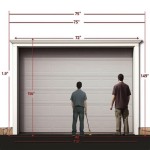How To Build A Garage Door From Scratch
Building a garage door from scratch can be a rewarding project for experienced DIY enthusiasts. This process requires careful planning, precise measurements, and a good understanding of construction techniques. The following guide outlines the steps involved in building a standard overhead sectional garage door.
Planning and Preparation: Begin by accurately measuring the garage door opening. This measurement will determine the dimensions of the door and the quantity of materials needed. Consider the desired material for the door, such as wood, steel, or composite. Each material offers different levels of durability, insulation, and aesthetic appeal. Research local building codes and regulations for garage doors to ensure compliance.
Material Acquisition: Based on the measurements and chosen material, create a detailed list of required materials. This list should include lumber for the frame (if building a wooden door), panels, hinges, rollers, tracks, springs, cables, and mounting hardware. Source these materials from reputable suppliers to ensure quality and consistency.
Frame Construction (for Wooden Doors): If constructing a wooden garage door, begin by building a sturdy frame. Use pressure-treated lumber for enhanced weather resistance. Cut the lumber to the required dimensions based on the door opening measurements. Assemble the frame using appropriate joinery techniques, such as mortise and tenon or strong adhesive and screws. Ensure the frame is square and level.
Panel Preparation: Whether using pre-cut panels or building them from scratch, ensure they are the correct size to fit within the frame. For wooden doors, panels can be constructed from plywood or tongue-and-groove boards. Consider adding insulation to the panels for improved energy efficiency. If using steel or composite panels, ensure they are designed for garage door applications.
Panel Attachment: Attach the panels securely to the frame. For wooden doors, use screws and adhesive. Ensure panels are evenly spaced and flush with the frame. For steel or composite doors, follow the manufacturer's instructions for panel attachment.
Hardware Installation: Install the hinges that connect the panels. Place hinges strategically to allow the door to bend and move along the tracks. Carefully align hinges to ensure smooth operation. Attach rollers to the top and bottom corners of each panel section. These rollers will run along the tracks.
Track Installation: Mount the horizontal tracks across the garage ceiling, ensuring they are level and aligned with the door opening. Install the vertical tracks that guide the door up and down along the sides of the opening. The tracks should be securely fastened to the wall and ceiling framing members.
Spring Installation: Garage door springs are under high tension and can be dangerous if not handled correctly. If uncomfortable working with springs, consult a professional. Install the springs according to the manufacturer's instructions. Torsion springs, mounted above the door, are common for heavier doors. Extension springs, mounted on the sides of the door, are often used for lighter doors.
Cable and Drum Installation: Install the cables that connect the springs to the bottom corners of the door. These cables help balance the door and assist in lifting and lowering. Wind the cables around the drums at the ends of the torsion spring shaft or attach them to the extension spring pulleys.
Safety Cables (Recommended): For added safety, install safety cables through the extension springs or alongside the torsion springs. These cables prevent the springs from recoiling dangerously if they break.
Handle and Lock Installation: Attach a handle to the outside of the door for manual operation. Install a lock mechanism, if desired, for added security.
Testing and Adjustment: After completing the installation, carefully test the door's operation. Ensure it moves smoothly along the tracks and balances correctly in the open and closed positions. Adjust the spring tension as needed to achieve proper balance. The door should stay in any position along the tracks without moving on its own.
Finishing (for Wooden Doors): If building a wooden door, apply a weather-resistant finish, such as paint or stain, to protect the wood from the elements and enhance its appearance. Follow the manufacturer’s recommendations for appropriate finishing products.
Regular Maintenance: Regular maintenance is crucial for the longevity and safe operation of a garage door. Lubricate moving parts, such as hinges, rollers, and tracks, periodically. Inspect the springs, cables, and other hardware for signs of wear and tear. Replace worn or damaged components promptly.

Building Huge Carriage Style Doors Moist

Building Bifold Garage Doors From Scratch Manmadediy

Building Carriage Doors From Scratch The Garage Journal

How To Frame For A Garage Door Doors Done Right And Openers

How To Build A Swing Out Garage Door

How To Build Garage Doors

9 Build Your Own Garage Door And Save Money

How To Make Garage Doors Www Shiva Com

Homemade Carriage House Garage Doors 14 Steps With Pictures Instructables

How To Build A Wood One Piece Garage Door Jonny Diy
Related Posts








